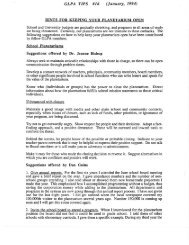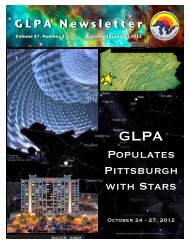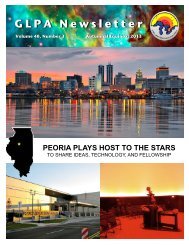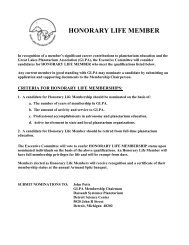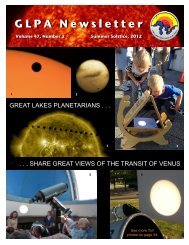continued - Great Lakes Planetarium Association
continued - Great Lakes Planetarium Association
continued - Great Lakes Planetarium Association
Create successful ePaper yourself
Turn your PDF publications into a flip-book with our unique Google optimized e-Paper software.
ARTICLES (<strong>continued</strong>) GLPA Newsletter Winter Solstice, 2010<br />
TECHNOLOGIES AD HOC COMMITTEE (TAC)<br />
Daniel R. Tell dtell@grmuseum.org<br />
You might have noticed your newsletter is extra thick (or the file is extra large, depending on your mode of delivery)<br />
this time around. Sorry, I’m afraid that’s my fault. It’s been decided to use this edition of the newsletter to introduce<br />
everyone to the new Technologies ad hoc Committee (TAC) that was created at the fall conference.<br />
Some of you at the conference attended our session, and most who attended also saw the presentation I gave at the<br />
end of the business meeting. For those of you who didn’t, I’m going to use the space here to introduce what TAC is and<br />
what we’re doing. Attached, you’ll also see the draft proposals on TAC projects that were submitted before the Executive<br />
Committee before the conference. I haven’t done much revision on these documents yet, so some of the material within<br />
them is out of date, and is waiting for this new committee to really get working full-steam.<br />
TAC was formed out of the Fulldome Special Interest Group (FSIG) at the last conference. As I explained to the<br />
Executive Committee though, the idea that fulldome video is a “special” interest isn’t necessarily the right way to look at<br />
it. We’re moving into a future in which all theaters will be affected by fulldome video. That is not to say all domes will<br />
convert to fulldome, but we are moving to a future in which all large theaters and major content producers will be working<br />
exclusively in the medium, so even those who remain “classical” theaters are going to be affected by this transition, if<br />
only in the availability of purchasable shows. Fulldome video isn’t a “special” interest, it concerns all of us.<br />
Thus the committee decided to transform FSIG into TAC to allow GLPA, on an organizational level, to attempt to<br />
represent the interests of all planetarians to vendors and content producers. Those at the fall conference know some of our<br />
vendors, during their presentations, mentioned how much they’ve appreciated and benefited from feedback received from<br />
us at our conferences and state meetings. It’s TAC’s goal to help improve this communication, streamline it, and make<br />
sure that all of us have our concerns being voiced.<br />
To start this mission, TAC is looking at a few projects to get us started:<br />
1) Creation of a TIPS booklet for classical domes converting to fulldome. Anyone who’s gone through this<br />
process knows there can be a lot of unexpected surprises along the way, and pooling our experiences in a<br />
manner that’s easy to access will be of great help for those who are converting, or even going from one<br />
fulldome system to another.<br />
2) Standards & practices for fulldome video. Fulldome video is a new medium, and to ensure best interoperability<br />
of prerecorded shows between facilities, and the ability for facilities with different fulldome systems<br />
to collaborate, industry-wide standards and practices should be adopted. This will involve things like<br />
standardizing dome master specifications (no, the dome master is not a standard already!), video and image<br />
compression and 3D model importation. The scale and nature of these have yet to be determined, and<br />
a few other organizations are working on this, but GLPA needs to make sure the wishes and desires of its<br />
membership are being expressed during this process. Any serious attempt at this will have to be a tremendous<br />
collaborative process with other organizations, the vendors themselves, and even the audio-visual<br />
industry beyond just the planetarium field, but few projects could be more important to ensuring that we<br />
remain the generous, collaborative field we’ve been for ages.<br />
3) Along with that, better developing guidelines to help fulldome content producers better back-convert their<br />
shows so they can be of use to classical domes, so they won’t be left without content in coming years.<br />
4) And, similarly, creating clear expectations for what features we expect, need and want from fulldome<br />
video systems, both to encourage existing vendors to best meet our needs, and assist new vendors entering<br />
the marketplace (fulldome video has only increased the number of vendors).<br />
5) And, from that, develop something of a system of “ratings” akin to the old Loch Ness/Sky-Skan/Joe Hopkins<br />
ratings to better clarify the functions and capabilities of different systems to assist planetarians (and<br />
our administrators) with best matching the systems available with our needs and desires.<br />
All of these are important things, and this is going to be a continuous, perennial process for GLPA to make sure<br />
we’re keeping things as up-to-date as possible, reflecting changes in technology and the greater A/V industry.<br />
20



